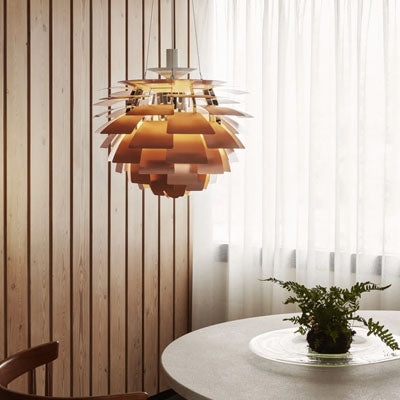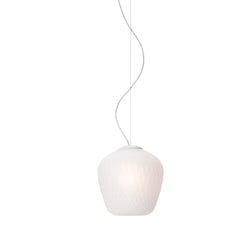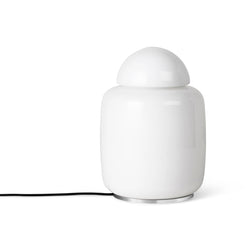Lighting is an essential part of the atmosphere and functionality of the home. The right kind of lighting not only illuminates, but it can change the look and usability of the entire space. Lighting also affects how different elements of the home, such as furniture and artwork, appear. Lighting needs can change depending on the day and season, so the placement of the lighting fixtures and the quality of the light are key. Battery-powered, rechargeable lamps are an excellent solution for flexible and easily movable mood lighting, especially in spaces where there are no electrical outlets nearby.


The color temperature of light is measured in kelvins (K). In general, residential environments use warm-toned light that varies between 2700 and 3300 K. This light is soft and homely, and is perfect for the living room, bedroom or other spaces intended for relaxation.
Brighter, more neutral light, 3300–4000 K, is a good choice for spaces where precision is needed, such as kitchens or workspaces. Light above 4500 K is cold and resembles daylight, and is generally not pleasant in living spaces.



The location of the lamp affects how the light is distributed in the room and what kind of atmosphere it creates. Here are some guidelines for placement:
In the living room, in addition to the ceiling lamp, you should consider floor lamps or table lamps, which are more comfortable for reading moments and creating an atmosphere. The recommended brightness of a reading lamp is usually around 400-500 lumens (lm) so as not to strain the eyes.


The height of the hanging lamp above the dining table is recommended to be approximately 55–70 cm from the surface of the table. This creates pleasant and glare-free lighting. If the table is also used for work, the lamp should produce bright and even light across the entire width of the tabletop. If the table is large, you should consider more lamps.


In the kitchen , work spaces, such as above the worktops, need bright spotlights so that working is safe and efficient.


Lighting often creates a calm and soft atmosphere in the bedroom . For example, you can use a dimmable ceiling lamp and table lamps on the bedside table, which bring light to reading moments.


In hallways, you should prefer low lamps such as ceiling lamps and wall lamps. Hanging lamps can be used if the height of the room is at least 260 cm, in which case they bring a sense of presence to the room.


In the bathroom, you need both bright working light around the mirror and mood lighting for relaxation. Use moisture-proof lamps, especially near water points.


Lamps placed at different heights and at different angles can bring dynamism and a sense of space to the room. Indirect lighting, where light is reflected through the ceiling or walls, for example, creates a soft and natural light without sharp shadows.


Color temperature and Kelvin values
The color temperature of light is measured in kelvins (K). In general, residential environments use warm-toned light that varies between 2700 and 3300 K. This light is soft and homely, and is perfect for the living room, bedroom or other spaces intended for relaxation.Brighter, more neutral light, 3300–4000 K, is a good choice for spaces where precision is needed, such as kitchens or workspaces. Light above 4500 K is cold and resembles daylight, and is generally not pleasant in living spaces.

Light quality and LED bulbs
The light quality is also affected by the type of bulb. LED bulbs are the recommended option for almost all lighting, as they are energy-efficient, long-lasting and offer a wide range of colors and light outputs.

Placement of the lamp
The location of the lamp affects how the light is distributed in the room and what kind of atmosphere it creates. Here are some guidelines for placement:In the living room, in addition to the ceiling lamp, you should consider floor lamps or table lamps, which are more comfortable for reading moments and creating an atmosphere. The recommended brightness of a reading lamp is usually around 400-500 lumens (lm) so as not to strain the eyes.


The height of the hanging lamp above the dining table is recommended to be approximately 55–70 cm from the surface of the table. This creates pleasant and glare-free lighting. If the table is also used for work, the lamp should produce bright and even light across the entire width of the tabletop. If the table is large, you should consider more lamps.


In the kitchen , work spaces, such as above the worktops, need bright spotlights so that working is safe and efficient.


Lighting often creates a calm and soft atmosphere in the bedroom . For example, you can use a dimmable ceiling lamp and table lamps on the bedside table, which bring light to reading moments.


In hallways, you should prefer low lamps such as ceiling lamps and wall lamps. Hanging lamps can be used if the height of the room is at least 260 cm, in which case they bring a sense of presence to the room.


In the bathroom, you need both bright working light around the mirror and mood lighting for relaxation. Use moisture-proof lamps, especially near water points.


Lamps placed at different heights and at different angles can bring dynamism and a sense of space to the room. Indirect lighting, where light is reflected through the ceiling or walls, for example, creates a soft and natural light without sharp shadows.





























